
The Ku Klux Klan, commonly shortened to the KKK or the Klan, is an American white supremacist, right-wing terrorist, and hate group whose primary targets are African Americans, Jews, Latinos, Asian Americans, Native Americans, and Catholics, as well as immigrants, leftists, homosexuals, Muslims, atheists, and abortion providers.
Ku Klux Klan auxiliaries are organized groups that supplement, but do not directly integrate with the Ku Klux Klan. These auxiliaries include: Women of the Ku Klux Klan, The Jr. Ku Klux Klan, The Tri-K Girls, the American Crusaders, The Royal Riders of the Red Robe, The Ku Klux balla, and the Klan's Colored Man auxiliary.

Zarephath is an unincorporated community and census-designated place (CDP) and located in Franklin Township, in Somerset County, New Jersey, United States, about 15 mi (24 km) north of Princeton. As of the 2010 United States Census, Zarephath's population was 37.

Alma Bridwell White was the founder and a bishop of the Pillar of Fire Church. In 1918, she became the first woman bishop of Pillar of Fire in the United States. She was a proponent of feminism. She also associated herself with the Ku Klux Klan and was involved in anti-Catholicism, antisemitism, anti-Pentecostalism, racism, and hostility to immigrants. By the time of her death at age 84, she had expanded the sect to "4,000 followers, 61 churches, seven schools, ten periodicals and two broadcasting stations."
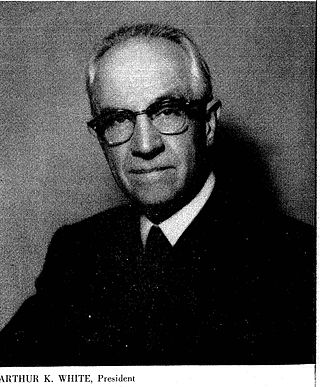
Arthur Kent White was a bishop, and the general superintendent of the Pillar of Fire Church in Zarephath, New Jersey, and the president of Belleview College. The church was started by his mother, Alma Bridwell White, in Denver, Colorado.

The Pillar of Fire International, also known as the Pillar of Fire Church, is a Methodist Christian denomination with headquarters in Zarephath, New Jersey. The Pillar of Fire Church affirms the Methodist Articles of Religion and as of 1988, had 76 congregations around the world, including the United States, as well as "Great Britain, India, Liberia, Malawi, Nigeria, the Philippines, Spain, and former Yugoslavia."

Alma White College was a Bible college in Zarephath, New Jersey from 1921 to 1978. It was an institution of the Pillar of Fire Church. The academic institution is now succeeded by Pillar College.

Women of the Ku Klux Klan (WKKK), also known as Women's Ku Klux Klan, and Ladies of the Invisible Empire, held to many of the same political and social ideas of the KKK but functioned as a separate branch of the national organization with their own actions and ideas. While most women focused on the moral, civic, and educational agendas of the Klan, they also had considerable involvement in issues of race, class, ethnicity, gender, and religion. The women of the WKKK fought for educational and social reforms like other Progressive reformers but with extreme racism and intolerance. Particularly prominent in the 1920s, the WKKK existed in every state, but their strongest chapters were in Ohio, Pennsylvania, Indiana, and Arkansas. White, native-born, Protestant women over age 18 were allowed to join the Klan. Women of the Klan differed from Klansmen primarily in their political agenda to incorporate racism, nationalism, traditional morality, and religious intolerance into everyday life through mostly non-violent tactics.

Arthur Hornbui Bell was an attorney and the Grand Dragon of the Ku Klux Klan in New Jersey.
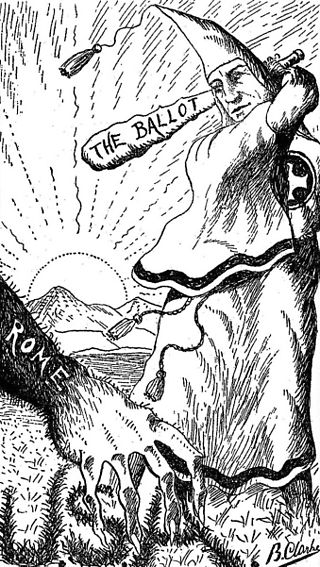
Heroes of the Fiery Cross is a book in praise of the Ku Klux Klan, published in 1928 by Protestant Bishop Alma Bridwell White, in which she "sounds the alarm about imagined threats to Protestant Americans from Catholics and Jews", according to author Peter Knight. In the book she asks rhetorically, "Who are the enemies of the Klan? They are the bootleggers, law-breakers, corrupt politicians, weak-kneed Protestant church members, white slavers, toe-kissers, wafer-worshippers, and every spineless character who takes the path of least resistance." She also argues that Catholics are removing the Bible from public schools. Another topic is her anti-Catholic stance towards the United States presidential election of 1928, in which Catholic Al Smith was running for president.

The Good Citizen was a sixteen-page monthly political periodical edited by Bishop Alma White and illustrated by Reverend Branford Clarke. The Good Citizen was published from 1913 until 1933 by the Pillar of Fire Church at their headquarters in Zarephath, New Jersey in the United States. White used the publication to expose "political Romanism in its efforts to gain the ascendancy in the U.S."

Samuel Green was a Grand Wizard of the Knights of the Ku Klux Klan in the late 1940s, organizing its third and final reformation in 1946.
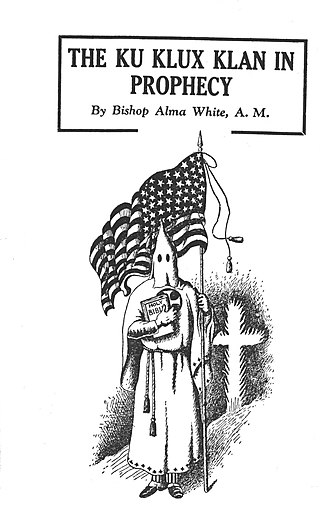
The Ku Klux Klan in Prophecy is a 144-page book written by Bishop Alma Bridwell White in 1925 and illustrated by Reverend Branford Clarke. In the book she uses scripture to rationalize that the Ku Klux Klan is sanctioned by God "through divine illumination and prophetic vision". She also believed that the Apostles and the Good Samaritan were members of the Klan. The book was published by the Pillar of Fire Church, which she founded, at their press in Zarephath, New Jersey. The book sold over 45,000 copies.

Klansmen: Guardians of Liberty was a book published by the Pillar of Fire Church in 1926 by Bishop Alma Bridwell White and illustrated by Branford Clarke. She claims that the Founding Fathers of the United States were members of the Ku Klux Klan, and that Paul Revere made his legendary ride in Klan hood and robes. She said: "Jews are everywhere a separate and distinct people, living apart from the great Gentile masses ... they are not home builders or tillers of the soil." Her book, which contains many anti-Catholic themes, became popular during the United States presidential election of 1928 when Al Smith was the first Catholic presidential candidate from a major party.
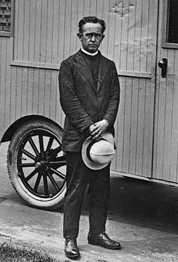
Branford Edward Clarke was an Evangelical preacher, poet and artist who promoted the Ku Klux Klan through his art which was drawn for the Pillar of Fire Church and their publications.
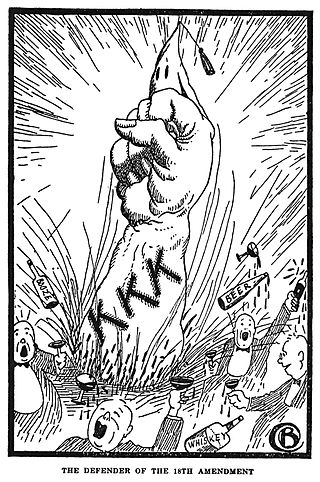
The Ku Klux Klan has had a history in the U.S. state of New Jersey since the early part of the 1920s. The Klan was active in the areas of Trenton and Camden and it also had a presence in several of the state's northern counties in the 1920s. It had the most members in Monmouth County, and operated a resort in Wall Township.
Known as the Crann Tara in Gaelic, the burning cross represented a signal fire, a method of communication among the clans and the rallying symbol of ancient Scotland and of the Highlanders in times of war.

The Ku Klux Klan is an organization that expanded operations into Canada, based on the second Ku Klux Klan established in the United States in 1915. It operated as a fraternity, with chapters established in parts of Canada throughout the 1920s and early 1930s. The first registered provincial chapter was registered in Toronto in 1925 by two Americans and a Torontonian. The organization was most successful in Saskatchewan, where it briefly influenced political activity and whose membership included a member of Parliament, Walter Davy Cowan.
Clansman, clansmen, Klansman, klansmen, or variations, may refer to:















